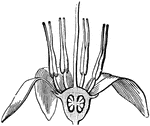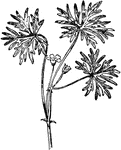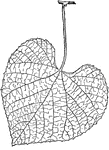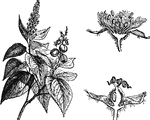775 illustrations of flowers and shrubs including: calla lily, camphor, candlewood, capsicum, carnation, cashew, castor-oil plant, catchfly, catkin, catnip, celandine, chamomile, checkerberry, chickweed, chicory, cinnamon, cinquefoil, cloudberry, clove, clover, cocoa, coffee, colocasia, comfrey, coreopsis, coriander, cornflower, cotton, cowbane, cowslip, crassula, creeper, crocus, and crowfoot.
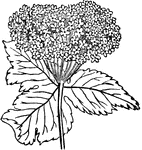
Cow Parsnip
"A genus of plants of the natural order Umbelliferae, having petals bent in at the middle, and flat…

Cowbane and Golden Alexanders
Of the Parsley family (Umbelliferae): left, cowbane (Oxypolis rigidior); right, golden Alexanders (Thaspium…

Cowslip
"A common native of pastures in England and many other parts of Europe, although rare in Scotland, a…
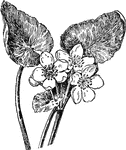
Cowslip
"It is a delicate, modest little flower, a great favorite for both its beauty and fragrance." Also called…
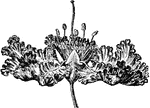
Crape Myrtle
Illustrated is one crape myrtle flower. The flowers are usually bright pink but sometimes there are…

Crape Myrtle
Crape myrtle is the common name of lagerstroemia indica. It is cultivated in India but probably native…

Crassula Quadrifida
Crassula quadrifida is a perennial with oblong leaves and white flowers tinged with red.

Orders of Crassulaceae, Saxifragaceae, and Cephalotaceae
Pictured are the orders of crassulaceae, saxifragaceae, and cephalotacea. The flowers of these orders…
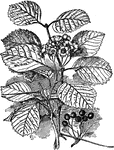
Crataegus Macracantha
Crataegus macracantha is a shrub of dense growth, growing twenty feet tall. It is native from New York…

Crataegus Oxycantha Paulii
The common name of crataegus oxycantha paulii is Paul's thorn. It has double, bright scarlet flowers.…

Crataegus Pinnatifida
Crataegus pinnatifida is native to China, Siberia, and Korea. It grows twenty feet tall. The fruit is…
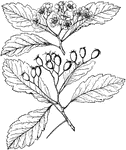
Crataegus Tomentosa
Crataegus tomentosa grows to twenty feet with spreading branches. The fruit is usually oval, dull yellow…
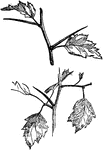
Thorns of Crataegus
The common names of crataegus are hawthorn and crategus. The thorns pictured are modified branches.…

Virginia Creeper
A plant which grows upon or just beneath the surface of the ground, or upon any other surface.
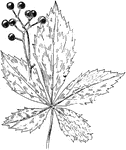
Virginia Creeper
Of the vine family (Vitaceae), the leaf and berries of the Virginia creeper (Psedera quinquefolia).

Creosote bush (larrea mexicana)
The creosote is a sticky, resinous bush with small round evergreen leaves, yellow flowers, woolly fruit,…

Crepis Rubra
The flowers are crepis rubra are red and usually grow alone at the end of each stem. It grows between…

Cress
"A name given to many plants, of which the foliage has a pungent, mustard-like taste, and is used as…

Pteris Cretica
A large type of terrestrial fern belonging to both tropic and sub tropic environments.
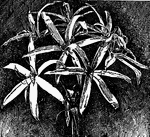
Crinum Americanum
The common name of crinum americanum is Florida swamp lily. There are usually four flowers on an erect…

Crinum Bulbs
Illustrated are bulbs are four different varieties of crinum. From left to right: C. moorei, C. giganteum,…

Crinum Moorei
Pictured is a young plant of crinum moorei. The bulb is oval and the neck is twelve to eighteen inches…

Crinum Powellii
Crinum powellii has about eight flowers. The flowers are a dark rose color. There are about twenty spreading…

Crocosmia Aurea Imperialis
Crocosmia aurea imperialis grows four feet high. The flowers are orange yellow.
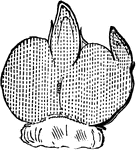
Crocus
Corm of a Crocus, the investing sheaths or dead leaf-bases stripped off. The faint cross-lines represent…

Crocus
Crocus (plural: crocus, crocuses) is a genus of perennial flowering plants, native to a large area from…

Crocus Imperati
Crocus imperati is native to Italy. The flower are lilac or white with yellow anthers.

Crocus Sativus
The common name of crocus sativus is saffron crocus. The leaves are as tall as the flower. It is the…
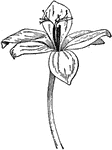
Crocus Speciosus Aitchisonii
Crocus speciosus aitchisonii has pale bluish lilac flowers. It is large and graceful.
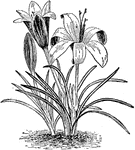
Crocus Susianus
The common name of crocus susianus is cloth of gold crocus. The flowers are orange-yellow and brownish…
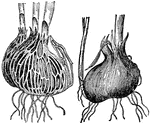
Crocus Tunics
Illustrated are reticulated and membbranaceous tunics. Crocus susianus is on the left and crocus sativus…

Crocus Vernus
Crocus vernus is the most common garden crocus. The flowers are lilac, white, or purple striped with…

Autumn Crocus
"Colchicum autumnale. 1. A corm in flower; 2. The same stripped of its outer coats, and showing the…
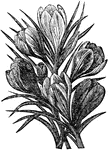
Crocuses
"The Crocus is well known as one of our earliest spring flowers, producing dense masses of richly colored…

Croton
Croton is an extensive plant genus of the family Euphorbiaceae established by Carolus Linnaeus in 1737.…
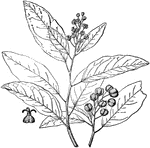
Croton Alabamensis
The croton alabamensis shrub grows six to nine feet tall. The plant is local to Alabama but rarely cultivated.

Crowberry
"A small procumbent shrub, of the natural order Empetraceae, a native of the northern parts of the world,…
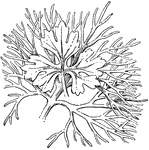
European Crowfoot Leaves
"Submerged and aerial leaves of a European crowfoot (Ranunculus Purshii). The leaf with thread-like…

Bristly Crowfoot
Of the crowfoot family (Ranunculaceae), the bristly crowfoot or Ranunculus Pennsylvanicus.
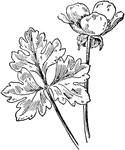
Bulbous Buttercup
Of the crowfoot family (Ranunculaceae), the leaf and flower (showing reflexed sepals) of the bulbous…

Canadian Anemone
Of the crowfoot family (Ranunculaceae), the Canadian Anemone or Anemone Canadensis.

Goldthread and Monkshood
Of the crowfoot family (Ranunculaceae): left, goldthread (Coptis trifolia); right, monkshood (Aconitum…
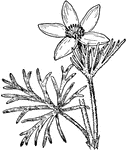
Pasque Flower
Of the crowfoot family (Ranunculaceae), the pasque flower or Anemone patens var. Wolfgangiana.





